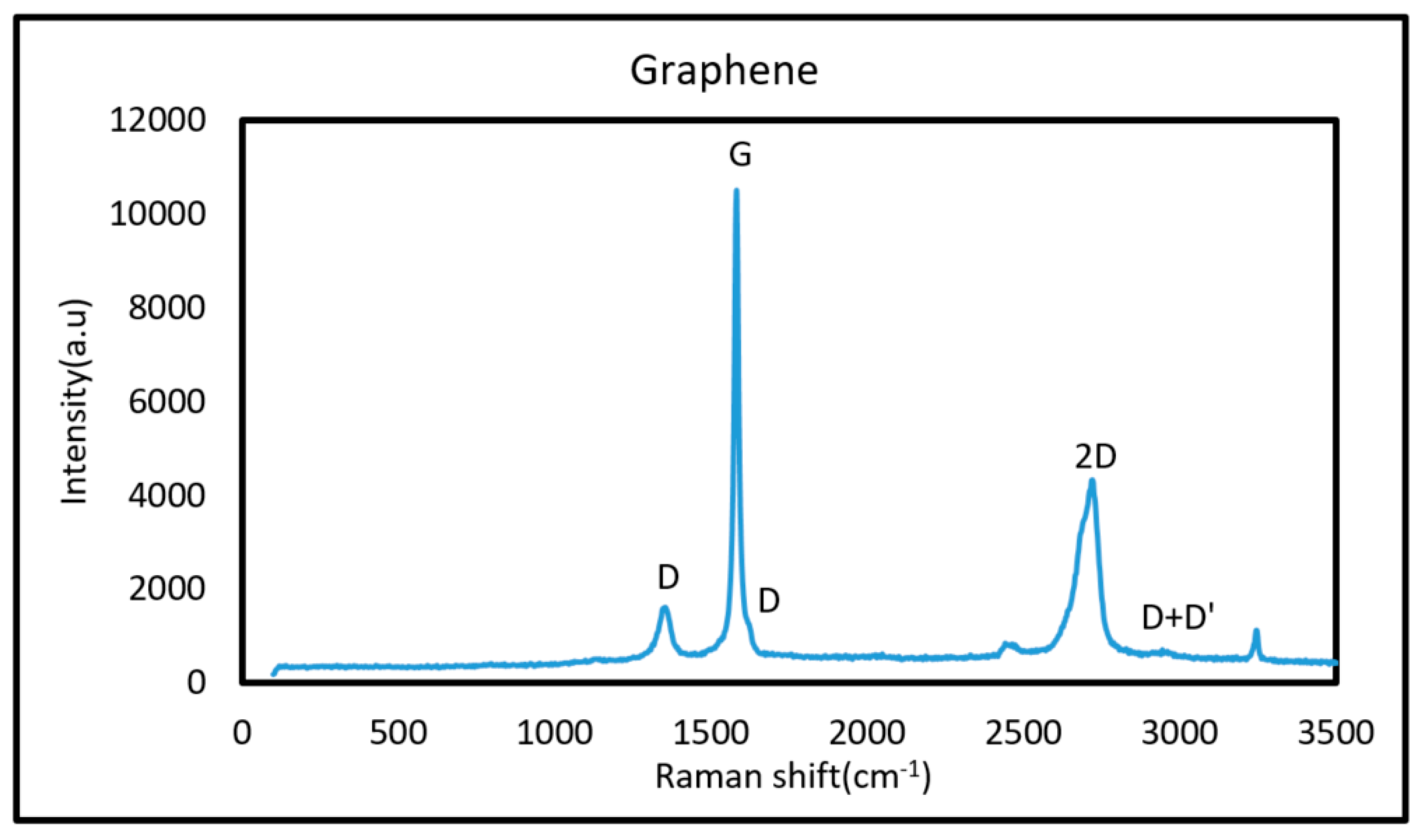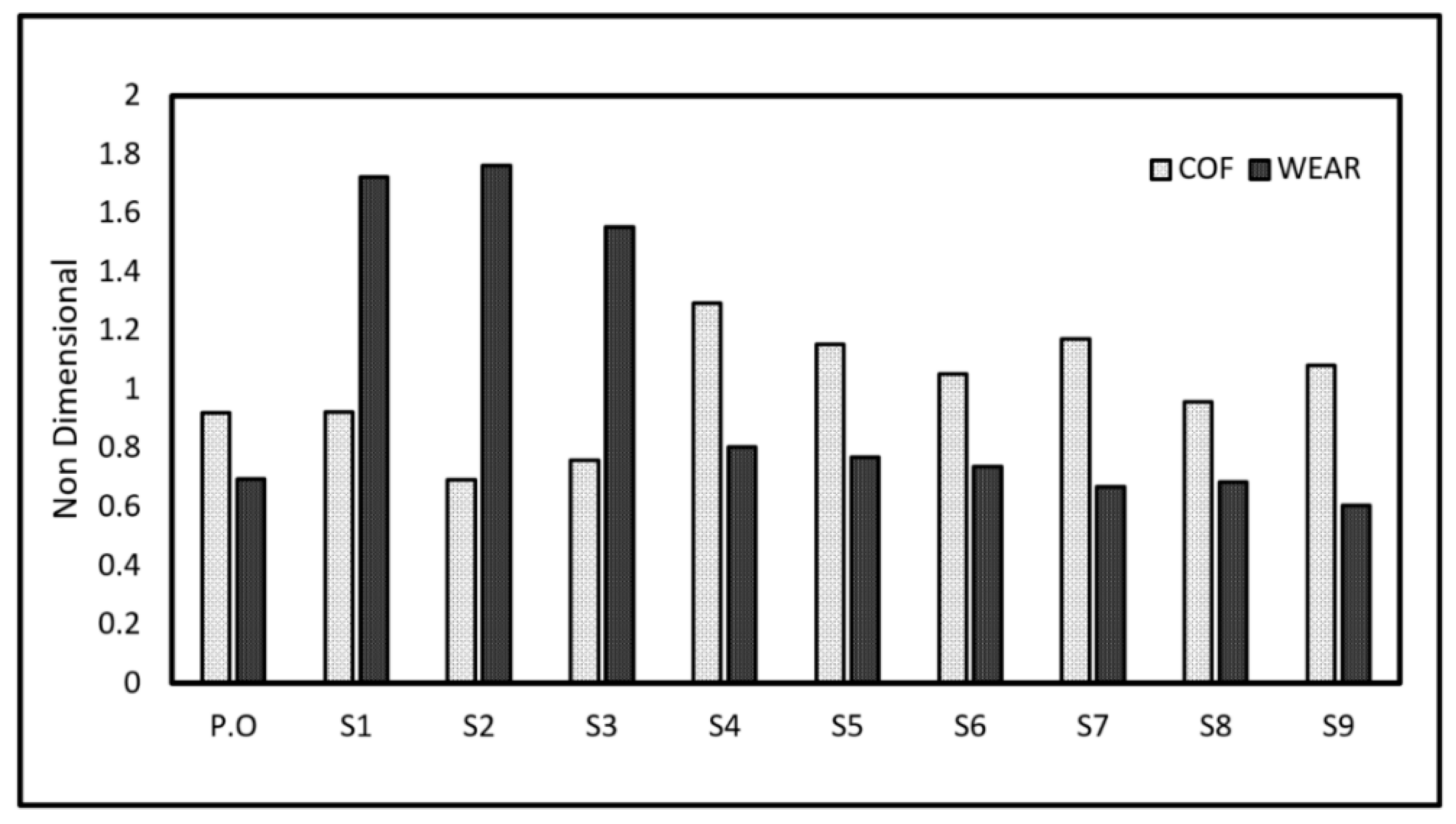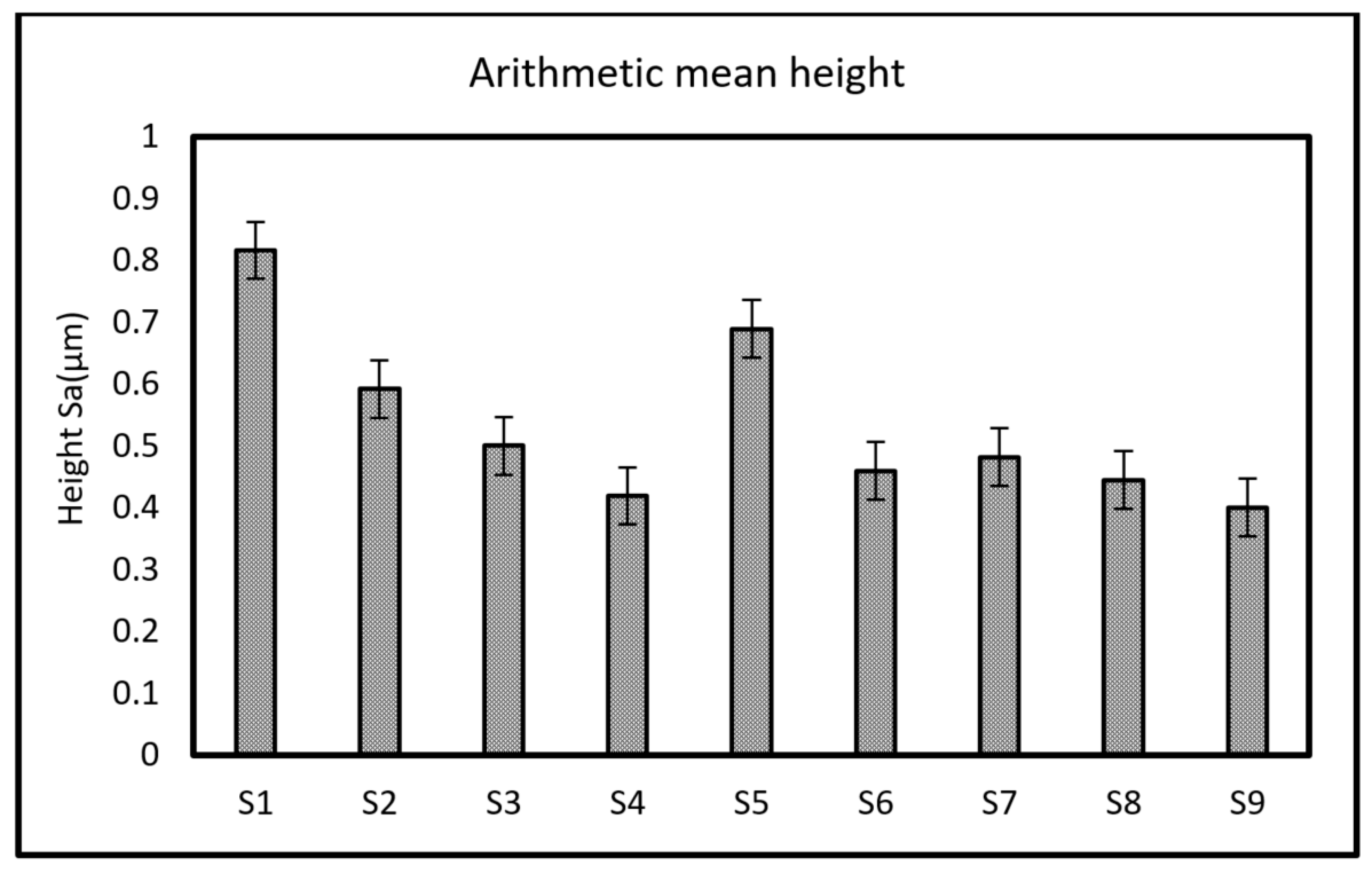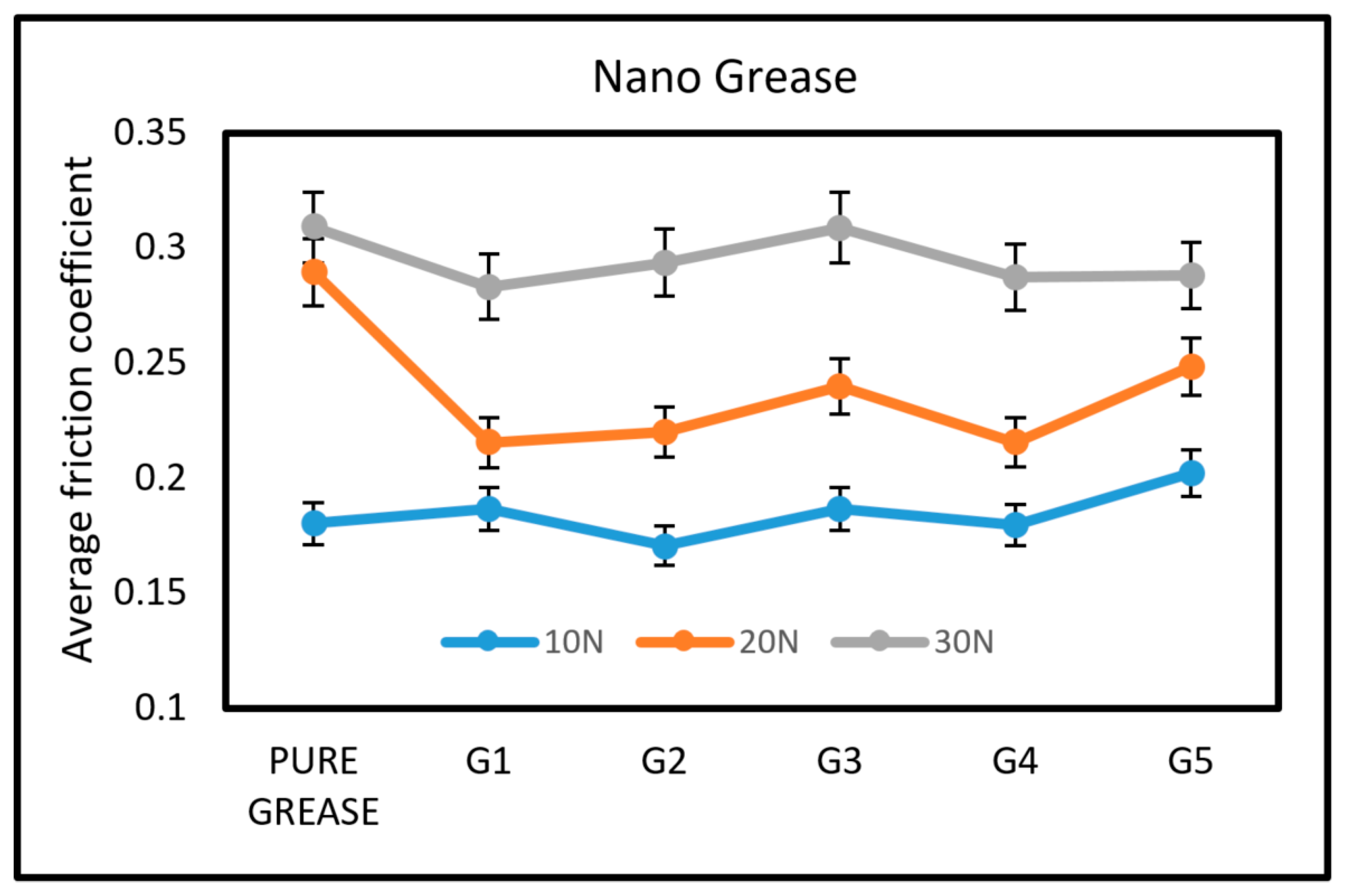Tribological Capabilities of Graphene and Titanium Dioxide Nano Additives in Solid and Liquid Base Lubricants
Abstract
:1. Introduction
2. Experimental Methods
2.1. Materials and Sample Preparations
2.1.1. Synthesis of Graphene and Titanium Dioxide
2.1.2. Nano Lubrication Preparation
2.2. Characterization
2.2.1. Raman Test
2.2.2. Viscosity
2.2.3. Rotating Pressure Vessel Oxidation Test (RPVOT)
2.2.4. TEM and SEM
2.2.5. Ball-on-Disk Test
2.2.6. Shaft-on-Plate
2.2.7. Statistical Analysis
3. Results
3.1. TEM Analysis
3.2. Raman Results
3.3. Kinematic Viscosity
3.4. RPVOT
3.5. Friction and Wear of Liquid Base Lubricants
3.6. SEM Microscopy
3.7. Frictional Results With Grease
4. Conclusions
Author Contributions
Funding
Acknowledgments
Conflicts of Interest
References
- Berman, D.; Erdemir, A.; Sumant, A.V. Graphene: A new emerging lubricant. Mater. Today 2014, 17, 31–42. [Google Scholar] [CrossRef]
- Stachowiak, G.; Batchelor, A. Lubricants and their composition. In Engineering Tribology; Elsevier: Oxford, UK, 2006; pp. 51–101. [Google Scholar]
- Choi, C.; Jung, M.; Choi, Y.; Lee, J.; Oh, J. Tribological properties of lubricating oil-based nano fluids with metal/carbon nanoparticles. J. Nanosci. Nanotechnol. 2011, 11, 368–371. [Google Scholar] [CrossRef]
- Alves, S.; Barros, B.; Trajano, M.; Ribeiro, K.; Moura, E. Tribological behavior of vegetable oil-based lubricants with nanoparticles of oxides in boundary lubrication conditions. Tribol. Int. 2013, 65, 28–36. [Google Scholar] [CrossRef]
- Kang, X.; Wang, B.; Zhu, L.; Zhu, H. Synthesis and tribological property study of oleic acid-modified copper sulfide nanoparticles. Wear 2008, 265, 150–154. [Google Scholar] [CrossRef]
- Kim, D.; Archer, L.A. Nanoscale organic- inorganic hybrid lubricants. Langmuir 2011, 27, 3083–3094. [Google Scholar] [CrossRef] [PubMed]
- Patel, J.; Kiani, A. Effects of reduced graphene oxide (rGO) at different concentrations on tribological properties of liquid base lubricants. Lubricants 2019, 7, 11. [Google Scholar] [CrossRef]
- Kamel, B.M.; Mohamed, A.; El Sherbiny, M.; Abed, K. Tribological behavior of calcium grease containing carbon nanotubes additives. Ind. Lubr. Tribol. 2016, 68, 723–728. [Google Scholar] [CrossRef]
- Liang, S.; Shen, Z.; Yi, M.; Liu, L.; Zhang, X.; Ma, S. In-situ exfoliated graphene for high-performance water-based lubricants. Carbon 2016, 96, 1181–1190. [Google Scholar] [CrossRef]
- Patel, A.; Guo, H.; Iglesias, P. Study of the lubricating ability of Protic ionic liquid on an aluminum–steel contact. Lubricants 2018, 6, 66. [Google Scholar] [CrossRef]
- Bhushan, B. Nanotribology and nanomechanics. Wear 2005, 259, 1507–1531. [Google Scholar] [CrossRef]
- Kang, J.; Wang, M.; Yue, W.; Fu, Z.; Zhu, L.; She, D.; Wang, C. Tribological behavior of titanium alloy treated by nitriding and surface texturing composite technology. Materials 2019, 12, 301. [Google Scholar] [CrossRef] [PubMed]
- Dong, H. Tribological properties of titanium-based alloys. In Surface Engineering of Light Alloys; Elsevier: Amsterdam, The Netherlands, 2010; pp. 58–80. [Google Scholar]
- Rai, R.; Shanmuga, S.C.; Srinivas, C. Update on photo protection. Indian J. Dermatol. 2012, 57, 335. [Google Scholar] [CrossRef] [PubMed]
- Weir, A.; Westerhoff, P.; Fabricius, L.; Hristovski, K.; von Goetz, N. Titanium dioxide nanoparticles in food and personal care products. Environ. Sci. Technol. 2012, 46, 2242–2250. [Google Scholar] [CrossRef] [PubMed]
- Mohammed, M.T.; Khan, Z.A.; Siddiquee, A.N. Surface modifications of titanium materials for developing corrosion behavior in human body environment: A review. Procedia Mater. Sci. 2014, 6, 1610–1618. [Google Scholar] [CrossRef]
- Hong, J.-Y.; Jang, J. Micro patterning of graphene sheets: Recent advances in techniques and applications. J. Mater. Chem. 2012, 22, 8179–8191. [Google Scholar] [CrossRef]
- Zhang, H.; Gruener, G.; Zhao, Y. Recent advancements of graphene in biomedicine. J. Mater. Chem. B 2013, 1, 2542–2567. [Google Scholar] [CrossRef]
- Li, P.F.; Zhou, H.; Cheng, X. Investigation of a hydrothermal reduced graphene oxide nano coating on Ti substrate and its nano-tribological behavior. Surf. Coat. Technol. 2014, 254, 298–304. [Google Scholar] [CrossRef]
- Berman, D.; Erdemir, A.; Sumant, A.V. Reduced wear and friction enabled by graphene layers on sliding steel surfaces in dry nitrogen. Carbon 2013, 59, 167–175. [Google Scholar] [CrossRef]
- Park, S.; Ruoff, R.S. Chemical methods for the production of graphene. Nat. Nanotechnol. 2009, 4, 217. [Google Scholar] [CrossRef]
- Penkov, O.; Kim, H.-J.; Kim, H.-J.; Kim, D.-E. Tribology of graphene: A review. Int. J. Precis. Eng. Manuf. 2014, 15, 577–585. [Google Scholar] [CrossRef]
- Fan, X.; Xia, Y.; Wang, L.; Li, W. Multilayer graphene as a lubricating additive in bentone grease. Tribol. Lett. 2014, 55, 455–464. [Google Scholar] [CrossRef]
- Eswaraiah, V.; Sankaranarayanan, V.; Ramaprabhu, S. Graphene-based engine oil nano fluids for tribological applications. ACS Appl. Mater. Interfaces 2011, 3, 4221–4227. [Google Scholar] [CrossRef]
- Zin, V.; Barison, S.; Agresti, F.; Colla, L.; Pagura, C.; Fabrizio, M. Improved tribological and thermal properties of lubricants by graphene based nano-additives. RSC Adv. 2016, 6, 59477–59486. [Google Scholar] [CrossRef]
- Joseph, D.; Tyagi, N.; Ghimire, A.; Geckeler, K.E. A direct route towards preparing pH-sensitive graphene nanosheets with anti-cancer activity. RSC Adv. 2014, 4, 4085–4093. [Google Scholar] [CrossRef]
- Kudin, K.N.; Ozbas, B.; Schniepp, H.C.; Prud’Homme, R.K.; Aksay, I.A.; Car, R. Raman spectra of graphite oxide and functionalized graphene sheets. Nano Lett. 2008, 8, 36–41. [Google Scholar] [CrossRef] [PubMed]
- Wang, H.L.; Robinson, J.T.; Li, X.L.; Dai, H.J. Solve thermal reduction of chemically exfoliated graphene sheets. J. Am. Chem. Soc. 2009, 131, 9910–9911. [Google Scholar] [CrossRef] [PubMed]
- Croce, A.; Arrais, A.; Rinaudo, C. Raman micro-spectroscopy identifies carbonaceous particles lying on the surface of crocidolite, amosite, and chrysotile fibers. Minerals 2018, 8, 249. [Google Scholar] [CrossRef]
- Gupta, S.K.; Desai, R.; Jha, P.K.; Sahoo, S.; Kirin, D. Titanium dioxide synthesized using titanium chloride: Size effect study using raman spectroscopy and photoluminescence. J. Raman Spectrosc. 2010, 41, 350–355. [Google Scholar] [CrossRef]
- Souza, J.C.; Henriques, M.; Teughels, W.; Ponthiaux, P.; Celis, J.-P.; Rocha, L.A. Wear and corrosion interactions on titanium in oral environment: Literature review. J. Bio- Tribo-Corros. 2015, 1, 13. [Google Scholar] [CrossRef]









| Characterization | Weight Concentration | Type of Additive in a Base Oil (99.9% Pure) |
|---|---|---|
| S-1 | 0.01% w/w | Graphene |
| S-2 | 0.05% w/w | Graphene |
| S-3 | 0.1% w/w | Graphene |
| S-4 | 0.01% w/w | Titanium dioxide |
| S-5 | 0.05% w/w | Titanium dioxide |
| S-6 | 0.1% w/w | Titanium dioxide |
| S-7 | 0.05% w/w | Graphene (50%) + Titanium dioxide (50%) |
| S-8 | 0.05% w/w | Graphene (25%) + Titanium dioxide (75%) |
| S-9 | 0.05% w/w | Graphene (75%) + Titanium dioxide (25%) |
| Characterization | Weight Concentration | Type of Additive in Grease (Commercial Grease) |
|---|---|---|
| G-1 | 0.5% w/w | Graphene |
| G-2 | 0.5% w/w | Titanium dioxide |
| G-3 | 0.5% w/w | Graphene (50%) + Titanium dioxide (50%) |
| G-4 | 0.5% w/w | Graphene (25%) + Titanium dioxide (75%) |
| G-5 | 0.5% w/w | Graphene (75%) + Titanium dioxide (25%) |
© 2019 by the authors. Licensee MDPI, Basel, Switzerland. This article is an open access article distributed under the terms and conditions of the Creative Commons Attribution (CC BY) license (http://creativecommons.org/licenses/by/4.0/).
Share and Cite
Patel, J.; Kiani, A. Tribological Capabilities of Graphene and Titanium Dioxide Nano Additives in Solid and Liquid Base Lubricants. Appl. Sci. 2019, 9, 1629. https://doi.org/10.3390/app9081629
Patel J, Kiani A. Tribological Capabilities of Graphene and Titanium Dioxide Nano Additives in Solid and Liquid Base Lubricants. Applied Sciences. 2019; 9(8):1629. https://doi.org/10.3390/app9081629
Chicago/Turabian StylePatel, Jankhan, and Amirkianoosh Kiani. 2019. "Tribological Capabilities of Graphene and Titanium Dioxide Nano Additives in Solid and Liquid Base Lubricants" Applied Sciences 9, no. 8: 1629. https://doi.org/10.3390/app9081629





